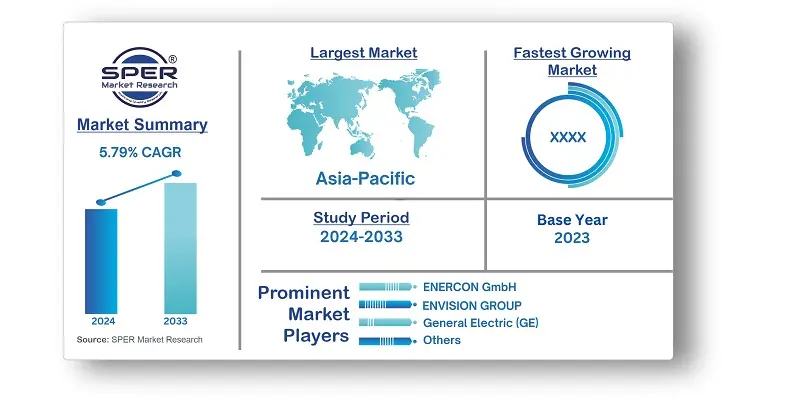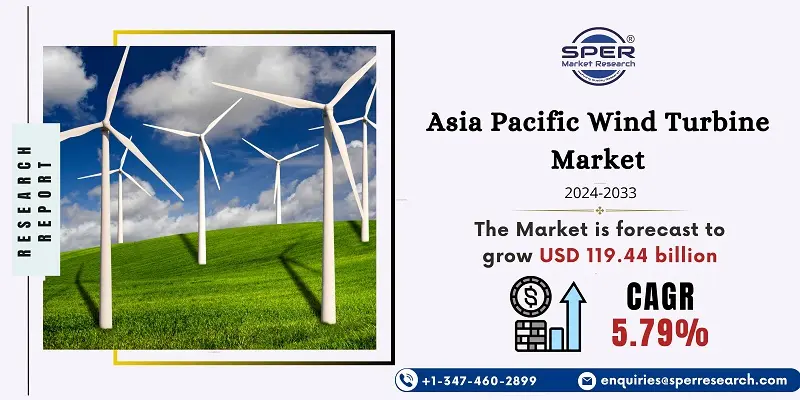
Asia Pacific Wind Turbine Market Trends, Share, Size, Revenue, Challenges and Future Outlook
Asia Pacific Wind Turbine Market Growth, Size, Trends Analysis- By Axis, By Installation, By Connectivity- Regional Outlook, Competitive Strategies and Segment Forecast to 2033
| Published: Oct-2024 | Report ID: POAE2488 | Pages: 1 - 159 | Formats*: |
| Category : Power & Energy | |||
- January 2024; For the Abukuma South Wind Power wind farm in Iwaki City and Hirono Ward, Fukushima, Japan, Abukuma South Wind Power LLC selected GE Vernova's onshore wind business as the supplier. In addition to signing a long-term full-service contract with GE Vernova, Abukuma South Wind Power also entered into a turbine supply agreement with Kandenko, EPC, to deliver 28 units of GE Vernova 3.2-103 turbines1 that can produce about 90 megawatts (MW) of power.
- September 2022; A 43 MW order was secured by Vestas and Mercury for the Kaiwera Downs wind farm in New Zealand. Ten V136-4.2 MW wind turbines with a 4.3 MW operating system are part of the project; Vestas supplied and installed them. Vestas will sign a 30-year Active Output Management 5000 maintenance and service contract (AOM5000) when the project is finished, which will maximize energy production and give Mercury long-term financial security for the wind farm.


| Report Metric | Details |
| Market size available for years | 2020-2033 |
| Base year considered | 2023 |
| Forecast period | 2024-2033 |
| Segments covered | By Axis, By Installation, By Connectivity. |
| Regions covered | Australia, China, India, Japan, South Korea, Rest of Asia-Pacific. |
| Companies Covered | ENERCON GmbH, ENVISION GROUP, General Electric, Goldwind, Mingyang Smart Energy Group Co, Ltd. |
- Utilities and Energy Companies
- Government Agencies and Regulators
- Manufacturers and Suppliers
- Investors and Financial Institutions
- Industrial and Commercial End-users
- Research Institutions and NGOs
- Technology Developers
| By Axis: | |
| By Installation: | |
| By Connectivity: |
- Asia Pacific Wind Turbine Market Size (FY’2024-FY’2033)
- Overview of Asia Pacific Wind Turbine Market
- Segmentation of Asia Pacific Wind Turbine Market By Axis (Horizontal, Vertical, Others)
- Segmentation of Asia Pacific Wind Turbine Market By Installation (Onshore, Offshore, Others)
- Segmentation of Asia Pacific Wind Turbine Market By Connectivity (Grid-connected, Stand Alone, Others)
- Statistical Snap of Asia Pacific Wind Turbine Market
- Expansion Analysis of Asia Pacific Wind Turbine Market
- Problems and Obstacles in Asia Pacific Wind Turbine Market
- Competitive Landscape in the Asia Pacific Wind Turbine Market
- Impact of COVID-19 and Demonetization on Asia Pacific Wind Turbine Market
- Details on Current Investment in Asia Pacific Wind Turbine Market
- Competitive Analysis of Asia Pacific Wind Turbine Market
- Prominent Players in the Asia Pacific Wind Turbine Market
- SWOT Analysis of Asia Pacific Wind Turbine Market
- Asia Pacific Wind Turbine Market Future Outlook and Projections (FY’2024-FY’2033)
- Recommendations from Analyst
1.1. Scope of the report1.2. Market segment analysis
2.1. Research data source
2.1.1. Secondary Data2.1.2. Primary Data2.1.3. SPER internal database2.1.4. Premium insight from KOLs
2.2. Market size estimation
2.2.1. Top-down and Bottom-up approach
2.3. Data triangulation
4.1. Driver, Restraint, Opportunity and Challenges analysis
4.1.1. Drivers4.1.2. Restraints4.1.3. Opportunities4.1.4. Challenges
4.2. COVID-19 Impacts of the Asia Pacific Wind Turbine Market.
5.1. SWOT Analysis
5.1.1. Strengths5.1.2. Weaknesses5.1.3. Opportunities5.1.4. Threats
5.2. PESTEL Analysis
5.2.1. Political Landscape5.2.2. Economic Landscape5.2.3. Social Landscape5.2.4. Technological Landscape5.2.5. Environmental Landscape5.2.6. Legal Landscape
5.3. PORTERs Five Forces
5.3.1. Bargaining power of suppliers5.3.2. Bargaining power of buyers5.3.3. Threat of Substitute5.3.4. Threat of new entrant5.3.5. Competitive rivalry
5.4. Heat Map Analysis
6.1. Asia Pacific Wind Turbine Market Manufacturing Base Distribution, Sales Area, Product Type6.2. Mergers & Acquisitions, Partnerships, Product Launch, and Collaboration in Asia Pacific Wind Turbine Market
7.1. Asia Pacific Wind Turbine Market Size, Share and Forecast, By Axis, 2020-20267.2. Asia Pacific Wind Turbine Market Size, Share and Forecast, By Axis, 2027-20337.3. Horizontal7.4. Vertical7.5. Others
8.1. Asia Pacific Wind Turbine Market Size, Share and Forecast, By Installation, 2020-20268.2. Asia Pacific Wind Turbine Market Size, Share and Forecast, By Installation, 2027-20338.3. Onshore8.4. Offshore8.5. Others
9.1. Asia Pacific Wind Turbine Market Size, Share and Forecast, By Connectivity, 2020-20269.2. Asia Pacific Wind Turbine Market Size, Share and Forecast, By Connectivity, 2027-20339.3. Grid-connected9.4. Stand Alone9.5. Others
10.1. Asia Pacific Wind Turbine Market Size and Market Share
11.1. Asia Pacific Wind Turbine Market Size and Market Share By Region (2020-2026)11.2. Asia Pacific Wind Turbine Market Size and Market Share By Region (2027-2033)11.3. Australia11.4. China11.5. India,11.6. Japan11.7. South Korea,11.8. Rest of Asia-Pacific
12.1. ENERCON GmbH
12.1.1. Company details12.1.2. Financial outlook12.1.3. Product summary12.1.4. Recent developments
12.2. ENVISION GROUP
12.2.1. Company details12.2.2. Financial outlook12.2.3. Product summary12.2.4. Recent developments
12.3. General Electric
12.3.1. Company details12.3.2. Financial outlook12.3.3. Product summary12.3.4. Recent developments
12.4. Goldwind
12.4.1. Company details12.4.2. Financial outlook12.4.3. Product summary12.4.4. Recent developments
12.5. Mingyang Smart Energy Group Co., Ltd
12.5.1. Company details12.5.2. Financial outlook12.5.3. Product summary12.5.4. Recent developments
12.6. ReGen Powertech
12.6.1. Company details12.6.2. Financial outlook12.6.3. Product summary12.6.4. Recent developments
12.7. Shanghai Electric
12.7.1. Company details12.7.2. Financial outlook12.7.3. Product summary12.7.4. Recent developments
12.8. Siemens Gamesa Renewable Energy, S.A
12.8.1. Company details12.8.2. Financial outlook12.8.3. Product summary12.8.4. Recent developments
12.9. Suzlon Energy Limited
12.9.1. Company details12.9.2. Financial outlook12.9.3. Product summary12.9.4. Recent developments
12.10. Others
SPER Market Research’s methodology uses great emphasis on primary research to ensure that the market intelligence insights are up to date, reliable and accurate. Primary interviews are done with players involved in each phase of a supply chain to analyze the market forecasting. The secondary research method is used to help you fully understand how the future markets and the spending patterns look likes.
The report is based on in-depth qualitative and quantitative analysis of the Product Market. The quantitative analysis involves the application of various projection and sampling techniques. The qualitative analysis involves primary interviews, surveys, and vendor briefings. The data gathered as a result of these processes are validated through experts opinion. Our research methodology entails an ideal mixture of primary and secondary initiatives.



Frequently Asked Questions About This Report
PLACE AN ORDER
Year End Discount
Sample Report
Pre-Purchase Inquiry
NEED CUSTOMIZATION?
Request CustomizationCALL OR EMAIL US
100% Secure Payment






Related Reports
Our Global Clients
Our data-driven insights have influenced the strategy of 200+ reputed companies across the globe.




















